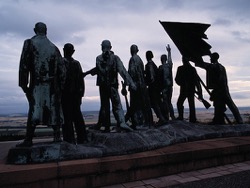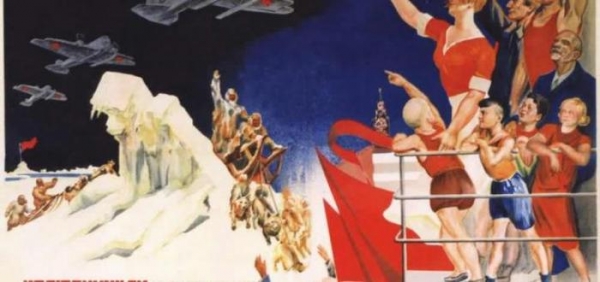
This year marks 25 years since the collapse of the Soviet Union, which occurred on December 25, 1991. The end of the Soviet Union marked in the history of mankind the end of the socialist experiment to transform the world.
It turned out that in vain were the sacrifices to build a happy future. Only during the Second world war about 27 million Soviet citizens died in the struggle against fascism, by giving freedom to the peoples of Eastern Europe and paving the way for anti-colonial revolutions in countries in the third world.
In the postwar period, imperialism ceased to be the undisputed hegemon in the world. The existence of the USSR, the European socialist countries, the socialist revolution in China and later in Cuba changed the balance of political forces in the world. Reactionary forces on the planet were forced to retreat. This process continued until the 70-ies of the last century.
Internal the onset of capitalism on the elimination of gains of workers, as well as external — against the spread of revolutionary and political transformations in the world, is particularly acute during the reign of Ronald Reagan in US and Margaret Thatcher in the UK.
And it happens not accidentally, but on the background of weakening domestic and external policies of the European Eastern bloc countries, which particularly begins to emerge in the second half of the 80 —ies.
In recent years we have written a number of books on the causes of the collapse of socialism in Europe. Most authors share the opinion of American political scientist Francis Fukuyama declared that only capitalism is the only possible system for humanity, and the socialist experiment is assessed as a wrong way of development of mankind, which has become a kind of “end of history” and of the struggle of ideologies.
In fact, this approach seems superficial and does not take into account the complexity of socialist construction, as well as the mistakes that led to the collapse of the socialist system.
Analysis of the construction of the socialist system in the Soviet Union is not only useful from a historical point of view but also from practical to learn lessons and avoid mistakes in the future.
“After many years of thinking I came to the following conclusion: among the many mistakes that have been made, the main is that we thought that someone knows what socialism is and how it can be built,” said Fidel Castro on 17 November 2005.
To understand the causes of the collapse of the Soviet Union should be addressed to the publications of well-known journalist Rosa Worlds Eliade (Rosa Miram Elizade), which analyzes different aspects of the issue, as well as the role of the media in this process. It would also be useful to consider an article published in the journal Temas, under the title: “Socialism, if not consciously absorbed, it stays on the surface”.
It should be noted that the ideas of socialism are still at the stage of social construction. They have never been consolidated in any country, real socialism in the Soviet Union or the modern processes of building socialism in China, Vietnam, Cuba or North Korea.
Studying the experience of building socialism in Eastern Europe and the Soviet Union, it should be noted that there are many common reasons that led to the collapse of socialism, but there are peculiarities. Their main mistake was that they believed in the opportunity as soon as possible to overcome social inequality and injustice, they inherited from capitalism.
This has always led to attempts to jump over certain stages of historical development of society. But experience shows that deep transformation in the construction of socialism require the implementation of fundamental changes in the minds of people, what we in Cuba call the “change of thinking”. This is a very difficult and long process.
The people themselves don’t change their mind and change their ideas. This happens only in cases when there is a change of relationship to the property. Need a deep cultural change, so that man could go from the capitalist individualism to collective thinking, social solidarity and economic governance on the basis of consensus. In this process a fundamental role is played by its own policy of socialism.
To this conclusion, at least conceptually, the society has come a long time. Lenin wrote that there is a big difference between nationalization and socialization of production.
Nationalization is a legal act that occurs in a specific point in time and changes the relationship to the property.
But not many people are willing to quickly feel themselves as owners of the property, which they inherited from capitalism.
However, a certain part of society — its avant-garde comes to this understanding much faster than others. This was proved in practice by Lenin in the first year of existence of the USSR.
In the course of the revolutionary conflict and civil war, Lenin comes to the conclusion that at the present time seems to be incorrect. In 1919 he offers to abandon the money since the civil war had practically demonetized society. Money is worthless, and people began to move to “barter” — changing some goods on the other.
It seemed that this path is correct. After all, Lenin, in practice, began to implement the ideas of Marx and Engels that the socialism won’t exist commodity-money relations.
The most complete is contained in the book “Anti-dühring”. Indeed, Marx and Engels talked about the transition from capitalism to the new socio-economic system — socialism. It seemed that this is achievable. Creates an international, rapidly developing revolutionary movement in European countries.
In 1920 he published a book “the ABC of communism, written by Bukharin in collaboration with the Transfiguration for young party members.
After the Civil war extraordinary measures for the management of the national economy has exhausted itself. There is a mass demobilization of farmers from the ranks of the red army. There is the daunting task of rebuilding a shattered economy.
It was obvious that when the country is 85% of the population are peasants, you cannot quickly change their attitude to property. Needed other mechanisms to stimulate output growth. It’s not enough to say that now the land belongs to the people, it is necessary to propose a new economic policy (NEP), which was proclaimed in March, 1921.
NEP made a split in the party ranks. A year earlier the party said that the country practically has all the conditions for the transition to a more advanced society. And then suddenly, in March 1921, they say that we should return to commodity-money relations, economic mechanisms to promote agricultural production. All this is presented under the brand name, it is impossible to ignore the history of Russia, the country is underdeveloped and to survive she needs to take a step back.
Comrade Lenin considered the NEP as a temporary retreat is necessary to create conditions for the subsequent transition to the socialization of production in the interests of the citizens of the whole country.
The idea of the need of promotion of this process were outlined by Lenin in one of his last works “On cooperation”, published in 1923. The founder of the Soviet state writes that the NEP is not the only mechanism for stimulating productive forces, the citizens must understand that only joint work on the basis of cooperation can provide a high standard of living for workers.
The initial period of building socialism in the USSR took place in conditions of emergency. War communism during the civil war helped to survive to the young state of workers and peasants. The NEP has undoubtedly yielded positive results in rebuilding the destroyed national economy. It should be noted that in 1926 the Soviet Union was able to reach the figures of pre-war 1913. The party starts discussion on the necessity of industrialisation, which would be able to bring the Soviet Union to a new qualitative level.
Unfortunately, in emergency situations there is a further aggravation of relations with the capitalist countries that are trying to destroy the nascent socialism. In the period from 1920 until the mid 30-ies against the Soviet state arranged numerous provocations: military aggression, sabotage, espionage, international isolation. With all these phenomena will face Cuba after the triumph of the Cuban revolution.
Naturally, the tactics to counter extraordinary circumstances table the norm in the process of building a socialist state. Many years later, Che Guevara will say that the NEP is not a universal method of construction of socialism and was characteristic for the initial period of building socialism in the USSR.
It’s safe to say that after the death of Lenin in January 1924, begin to develop various responses to extraordinary circumstances that are not always up to date. In particular, it concerns the plan of accelerated collectivization — the process of combining the sole of the peasant farms into collective farms (kolkhozes) in the period from 1929 to 1934. The Soviet Union abandoned the Leninist plan of cooperation, engagement with the farmers through persuasion and cooperation. Instead I chose the path of repression, searching for the enemy in all spheres of life of the young Soviet state.
On the other hand, we should not forget that Lenin was gravely ill and could not lead the country in such difficult times, when everywhere there were threats of the October revolution.
In his political Testament — “Letter to Congress”, Lenin warned of the danger of a split in the party due to disagreements between Stalin and Trotsky and that Stalin, having become General Secretary, concentrated in his hands an immense power, and fails always quite careful to use that power. This danger quickly materialized after his death.
Thus, the country embarked on the path that led to the distortion of the essential conditions necessary for the victory of socialism — a political consensus. It should be recalled that during the life of Lenin, in 1921, during the Kronstadt revolt, measures were taken to prevent factionalism in the ranks of the party and departure from its General line, in order to avoid intra-party rift.
However, since 1923, internal divisions begin to appear in the issue of industrialization of the country. The position of the Trotskyists has been sharply criticized. Later, in 1926, during the discussion, the accused Bukharin and Preobrazhensky supported his “left opposition” in the planting of “military-feudal exploitation of the peasantry” and “internal colonialism”. At the end of 1927, the debate on this question cease, and the country makes a radical change from the NEP. Main characters disappear from the political scene.
Serious violations of the principles of socialist democracy has reached its critical point, since 1936, and led to massive political repression.
In the course of the four political processes were subjected to physical destruction of the command personnel of the red army and the Bolshevik – Communist party. All of them were charged with counter-revolutionary terrorist activities and treason. Political repression has caused irreparable damage to the ideas of socialism in the world and is mostly responsible for the collapse of socialism in Europe.
However, the faith of the Soviet people in the socialist ideas helped them win the great Patriotic war and the cost of enormous effort to rebuild the country for several years.
It should be noted that in the postwar period economic problems required the adoption of effective solutions. Since 1917, the question of building socialism in Russia was not given much importance to the interaction mechanisms of market and planned economy.
Largely this was due to a misunderstanding for years of essence of commodity-money relations.
It is quite clear that it is impossible in a short time change people’s mentality, which for many centuries was influenced by capitalist selfishness. Likewise, it is impossible overnight to change the country’s economy. This is a complex process designed for the long term and tied to the growth of the productive forces. Unfortunately, to resolve this issue have so far failed.
Remains unresolved and the issue of compliance with the interests of the state and the individual. How to find a balance of their interests, sometimes quite the opposite? Through the market? The market does exist and that it determines a certain level of development of society, but he is not able to change after the nationalization of the means of production.
Explanations of why under socialism continue to exist the market, ambiguous, and sometimes contradictory.
The first such attempt was made by the Soviet economist Preobrazhensky, in the 20-ies of the last century. In his view, market relations exist under socialism, because there are different types of ownership: state, private, cooperative. Different types of ownership must somehow interact, and what is happening in the market.
The explanation is quite reasonable. But not giving response to such a serious problem: how can he exist in an environment of state ownership?
What is the money for economic calculation, accounting, loans, if there is only one form of ownership — public?
In terms of functioning of the state economy, it is difficult to understand why this happens. Moreover the market in fact existed, when there was no private property, when the owner of the goods was at the same time and its manufacturer.
Over many years and failed to find a decent answer as to why in conditions of total state ownership continue to operate the market.
In 1935 adopted a formula of economic calculation under socialism, when it was made, a serious mistake, because economic calculation was of a formal nature and did not contain anything specific.
In 1951, against the background of growing economic problems in the USSR began a new discussion on the question of extensive growth of the economy. Stalin in 1952 he published the book “Economic problems of socialism in the USSR”. In his work, he revisits the issue of commodity-money relations in the conditions of existence of different forms of ownership.
This question remained without a scientific solution to 60 – ies of the last century. Within the framework of Soviet economic reforms in the period from 1958 to 1965 economists have tried to answer this question.
It was based on the first volume of “Capital” and was as follows. In the conditions where producers are isolated from each other, it is necessary to find a mechanism that would have tied their common interests. This mechanism is the market.
Thus, the relative economic isolation, even under conditions of public ownership and lack of private property, to determine the existence of market relations under socialism.
Unfortunately, this explanation is late for 60 years, the result of which was seriously damaged not only the political economy of socialism, but the theory of building a socialist society.








